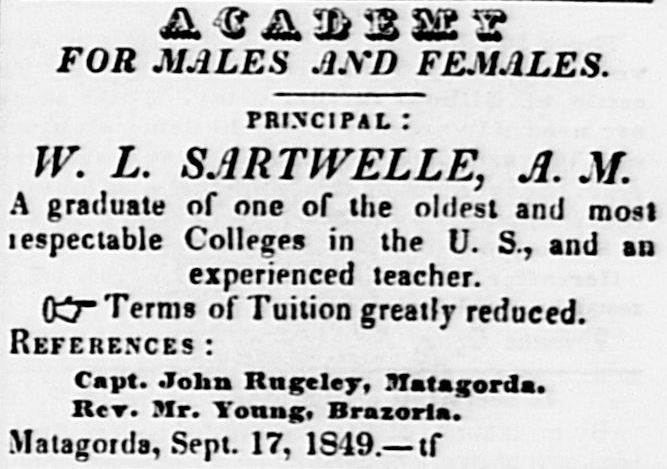|
|
|||
 W. L. Sartwelle Academy for Males and Females Colorado Tribune, July 21, 1851 |
|||
|
A. fifth generation American, William Lovell Sartwelle, son of Asa and Mary Sartwelle, was born February 4, 1821, in Charleston, New Hampshire, and was baptized and confirmed as an Episcopalian at the Union Episcopal Church, Claremont, New Hampshire, in 1839. In 1840, at age nineteen, he was awarded a Master of Arts degree from Dartmouth. He studied law in a Claremont, New Hampshire, law office, taught school in Alabama, and was admitted to the Alabama Bar in April, 1846. A few months later he moved to Matagorda and was admitted to the Texas Bar in September, 1846, however he did not practice, as he wrote, “little doing in the profession. Can’t make a living at it at present.” The next year (1847) Sartwelle formed a co-partnership with the Rev. Caleb S. Ives, Rector of Christ Episcopal Church, to resume his teaching career at the Matagorda Institute. A devout Episcopalian, Sartwelle served as a Matagorda delegate to “The Primary Convention” of the new Episcopal Diocese of Texas held in Matagorda, January 1, 1849, and thereafter continued a lifelong service to God and his church as an Episcopal lay reader, several times as vestryman of Christ Church, and as a delegate to diocesian conventions.
Sartwelle married Helen Milne Dinsmore, the surviving child of Judge
Silas Dinsmore, in Christ Episcopal Church, Matagorda, on July 18,
1850, and they became the parents of a son, William Dinsmore
Sartwelle, on May 2, 1852, in Matagorda. In late 1853 or early 1854,
a second son, Henry, was born but died in infancy. The couple had no
other children.
Mrs. Sartwelle and her mother, Amanda (Coan) Dinsmore, had inherited
several thousand acres of land in the Matagorda area, as well as a
small ranch in Lavaca County. Besieged by the debts of Judge
Dinsmore and declining enrollment at the institute, Sartwelle gave
up his teaching career in Matagorda and moved to the Lavaca County
ranch in 1860, where he rather unsuccessfully endeavored to farm and
operate a cattle and sheep ranch. It was from the “Sarvaca” ranch
that the lawyer-teacher entered the Confederate army, and served
“during the whole period of our late deplorable Civil War.” Like
many other families of the era, the soldier’s wife, child, and
mother-in-law nearly perished of poverty on the banks of the Lavaca
River during his absence. On Sartwelle’s return home, he continued
his agricultural pursuits and his ministry as an Episcopal
lay-reader, riding horseback the seventeen miles to Hallettsville to
conduct church services there, occasionally several times a week.
Times were hard in the Reconstruction Era, but despite their
poverty—and because Sartwelle’s mother still lived in Claremont, New
Hampshire—in 1867 his son, William Dinsmore, was taken East to a
preparatory school, the Rectory School in Saybrook, Connecticut.
Upon completion of his studies at Saybrook, William enrolled in
Trinity College, Hartford, Connecticut, and then attended a New York
seminary, where he was ordained a deacon in the Episcopal church
March 18, 1876, and ordained as a priest June 3, 1877. His first
assignment was as rector of St. Paul’s Episcopal Church in Waco,
Texas.
As the Dinsmore-Duncan (sisters Amanda Dinsmore and Julia Duncan)
families has been almost inseparable since their joint residence in
Mobile, Helen Milne Dinsmore and Sarah Jane Duncan (first cousins)
had grown up together and were as close as sisters—infants together
in Mobile and schoolmates in the Reverend Caleb Ives’ schools in
Mobile and Matagorda, summering together at “Canmore” on Well Point
and wintering often on Caney Creek. About 1850 Captain John Duncan
began investing rather heavily in lands in Comanche County, and as
the Reconstruction Era eroded the profits of the Caney Plantation,
turned his attention more and more to Comanche. His daughter, Sarah
Jane, eventually moved to Comanche sometime prior to Captain
Duncan’s death in March, 1878. It is little wonder that the W. L.
Sartwelles and Amanda Dinsmore moved from Lavaca County to Comanche
in 1877, to be nearer their minister son in Waco and Helen Milne’s
cousin, Sarah Jane (Duncan) Walcott.
In Comanche, Sartwelle established a successful insurance agency and
he continued his ministry as an Episcopal lay reader, holding
services in any vacant building available. His labors were rewarded
some ten years later (18871) when St. Matthew’s Episcopal Church was
organized and a church building constructed.
Following their son’s marriage in 1878, and as grandchildren began
to appear, W. L. and Helen Milne Sartwelle assiduously assumed their
role as grandparents and part-providers for their minister-son’s
family and graciously served as “home base headquarters” for the
itinerant preacher’s every-growing number of children (eventually
seven, not one of which shared the same birthplace). Eventually the family was reunited in Comanche in 1892, as a result of the transfer of the minister-son as Priest-in-Charge of St. Matthew’s Church, Comanche. In 1891, a year prior to the reunion, Amanda Dinsmore died in Comanche and was buried there.
Historic Matagorda County, Volume I, pages 91-92 |